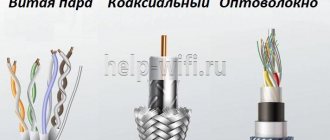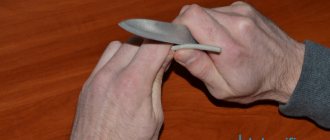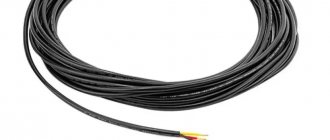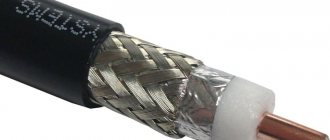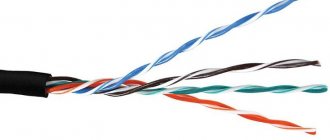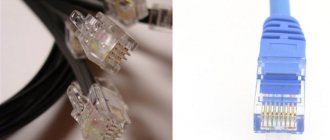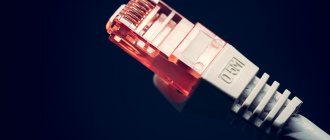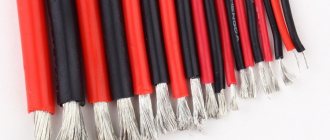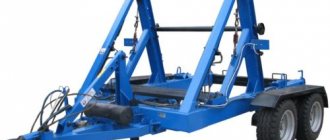When building local networks of various levels and scales, the main connecting interface is a twisted pair cable. 30 years ago he managed to win the coaxial analogue technology war, and today it is the most common type of communication between individual computers and other devices designed to transmit digital data. In particular, it is also used by Internet service providers, delivering network traffic to end consumers.
What is a twisted pair cable?
Interweaving wires in pairs is an invention that is more than 150 years old. Initially, this method of organizing communication was used for telegraph communication, then for a long time twisted pair became the standard for analog telephony. Twisting has proven to be an effective measure to counteract external electromagnetic interference while protecting against internal interference.
Currently, the term “twisted pair” is used primarily in relation to computer networks, having been transformed from two-pair to four-pair.
Structure of a twisted pair cable
Currently, the main physical medium for data transmission in structured cabling systems is twisted pair copper cable.
. Twisted pair has gained recognition due to the wide variety of designs, relatively low cost and ease of installation. There is a special classification that makes it easier to select and work with cables, and explains what stages of development the twisted pair went through to acquire its modern appearance. This is exactly what we will look at in this article, as well as general information about twisted pair.
Invention of twisted pair
In 1876 Alexander Bell
, an American inventor of Scottish origin, patented a method and device designed to transmit speech and other sounds by telegraph using electrical waves - the telephone. The fate of the device is known - enormous popularity among all levels of society and an integral part of our existence in the 21st century.
Initially, due to electromagnetic radiation from tram lines, telephone wires experienced severe interference. This forced specialists to look for ways to protect high-voltage electrical networks. The first step was the method of transposition of wires, which was based on the principle of crossing them through a certain number of supports. As a result, this was the first attempt to use twisted wire, which gave positive results - this is how twisted pair
.
One and a half million telephones were installed in the United States alone. As a result, this required laying a huge amount of cable and, accordingly, improving it (the connection was not of good quality). In 1881, Alexander Bell invents the “twisted pair” cable, originally intended for telephone networks. This type of cable consisted of one or more twisted pairs of conductors, insulated from each other. Covered with a sheath to protect the wire from external mechanical and natural influences.
With the gradual evolution of wired communications, twisted pair cable has also evolved and today is an integral part of structured cabling networks.
What is twisted pair?
Before talking about the classification of twisted pair, you need to understand what a twisted pair copper cable is.
twisted pair
is a cable that consists of one or more pairs of insulated copper conductors, twisted together and coated with an outer dielectric polymer sheath. Twisted conductors have a constant, clearly defined twist pitch, which is individual for each pair in order to compensate for crosstalk inside the cable. In simple words, twisting of conductors with different and non-multiple pitches for different pairs is performed so that the signals of the twisted pairs have a minimal impact on each other.
Twisted pair: basic elements
Currently, there are different cable designs that combine certain basic elements.
It is also worth noting that the twisted pair design does not necessarily have to include all of the following elements. For example, a drain conductor or shield is not included in the design of every twisted pair but only applies to shielded cables (F/UTP, F/FTP, and so on). Twisted pair elements
- Copper conductors are made from pure electrical copper of a high purity level. The cores can be either solid (Solid) or stranded (Stranded). Let's look at this point in a little more detail:
Solid (single core)
– each conductor is a monolithic copper wire. A cable with solid cores is in most cases used for laying cable routes and is not used for direct contact with active equipment. This is due to the fact that the solid core has a large diameter and does not tolerate frequent bending. But it should be noted that this type of cable has higher transmission characteristics.
Twisted pair design
Stranded (multi-wire)
– each conductor is made of several thin copper strands twisted together. Cables with multicore conductors are resistant to periodic physical impacts, such as kinks and twists. But unlike cables with single-core conductors, they have a higher level of signal attenuation, which limits the maximum data transmission distance. Most often, such cables are used to make patch cords for connecting active equipment to patch panels or connecting terminal equipment.
Twisted pair design
– Insulation protects the cores from oxidation and also insulates them from each other. In most cases it is made of high-density polyethylene (HDPE) or polyethylene foam (for categories 6A and above). In some cases, Teflon is used, which has a wide operating temperature range.
– A pair of conductors is the main part of a symmetrical cable, formed by two insulated conductors twisted together. To reduce the mutual influence of pairs on each other, different pairs are manufactured with different and non-multiple twisting pitches.
– The separator is designed for physical separation of pairs in the absence of their individual shielding. Found primarily in Category 6 and 6a cables.
– Drain wire is a grounding element that ensures continuity of the film screen in the event of its rupture, and also collects the induced signal from the film screen to ground it.
– The breaking thread is used to cut the outer sheath of the cable; when pulled, this thread leaves a longitudinal cut behind itself and opens access to the cable core.
– Protective film is a polypropylene tape wrapped in several layers around the cable core. Provides protection and insulation of pairs, as well as separation from the cable screen.
– A foil film screen is a polypropylene film metallized with aluminum, which attenuates interference induced on the cable from the external environment. This is the basic shielding option.
– Individual shielding of pairs – aluminum metallized polypropylene film to ensure the best isolation of pairs from each other.
– Tinned copper wire screen is a braided wire that provides better shielding and also has high physical resistance. Also acts as a drainage wire.
– Outer sheath – protects the internal elements of the cable from external influences, such as cold, moisture, solar (ultraviolet) rays and physical stress.
In most cases, the outer shell is made of polyvinyl chloride (PVC)
, or from polymers that do not support combustion and do not emit halogens during combustion
(LSZH)
. The slight fragility of the outer shell required during the cutting process is achieved by adding a certain amount of chalk to the feedstock. Cables with a PVC sheath are mainly used for single installation inside buildings and structures. For group installation indoors where large crowds of people are possible, cables with an LSZH sheath are used.
For outdoor installations, it is customary to use twisted pair cables in a polyethylene (PE)
, it is not afraid of ultraviolet radiation, resistant to cold and external influences. Cables with this sheath spread fire even when laid alone, so laying such cables in buildings and structures is strictly prohibited.
Also, do not forget that there are special-purpose shells, for example, fire-resistant (FR - PVC, FR - LSZH)
, which remain operational under the influence of flame, or universal shells
(UV - LSZH, UV - PVC)
, which are used for both external and internal installation.
Twisted pair designs
Depending on the presence or absence of additional shielding coatings for individual pairs and/or the core as a whole, the twisted pair is divided into shielded and unshielded
.
In turn, the type of shielding - copper or aluminum braid or foil shield around the pairs - determines the type of twisted pair. According to the International Standard ISO/IEC 11801, a combination of several letters, the so-called letter code,
, which has the following form: general shield type for the cable/individual shielding type for each individual pair, for example, F/UTP.
ISO/IEC 11801 standard uses the following designations:
- TP (Twisted Pair) – twisted pair.
- U (Unscreened) – without a protective screen.
- F (Foil Screened) – screen made of foil film.
- S (Braid Screen) – screen made of wire braid.
Now let's take a closer look at the main types:
1) U/UTP
– the name speaks for itself, the cable does not have a protective screen. Despite the lack of a screen, it is widely used due to its flexibility, low cost and ease of installation. The most popular design for laying cable systems in most countries.
Twisted pair U/UTP
2) F/UTP
– the cable has one outer shield made of aluminum foil, which is used as a basic type of protection against external interference.
Twisted pair F/UTP
3) SF/UTP
– an additional copper braided screen significantly increases the cable’s noise immunity in the mid- and low-frequency range, provides additional physical strength and protection from bending.
Twisted pair SF/UTP
4) U/FTP
– each pair is protected by foil film, which provides excellent shielding not only from external interference, but also from mutual influences between cable pairs. This solution is used for high-speed cables starting from category 6.
Twisted pair U/FTP
5) F/FTP
– the cable has foil protection for each individual pair and a common outer shield. Multi-layer protection for maximum noise immunity.
Twisted pair F/FTP
6) S/FTP
– individual shielding for each pair and a common external shield in the form of a wire braid. The design combines all the advantages of both types of shielding and provides excellent protection over the entire frequency range. It is used on cables of categories 6A, 7, 7A and 8, as well as to protect lines running in close proximity to power cables.
Twisted pair S/FTP
Categories and classes of twisted pair
The maximum transmitted frequency range is a fundamental parameter when dividing twisted pair cables into categories/classes. At the moment, the main standards governing the ranking of twisted pair cables into categories/classes are the International Standard ISO 11801 and the American Standard TIA-EIA-568B.
ISO 11801 defines the following classes for twisted pair cable: Class A, Class B, Class C, Class D, Class E, Class EA, Class F and Class FA. The higher the class, the better the transmission characteristics and transmission speed. It is also worth noting that a higher-class twisted pair cable supports the capabilities of a lower-class twisted pair cable, but not vice versa.
In the American standard TIA-EIA-568B there is no concept of classes and the concept of category
. To designate them, it is customary to use the abbreviation “Cat.X”, where X is a number from 1 to 8. Now let’s take a closer look at the categories/classes of twisted pair cables, as well as the correspondence between a specific category and class:
Cat. 1
(frequency 0.1 MHz) – used to transmit voice or data using a modem. In most cases, it consists of 1 pair of twisted conductors (in Russia it is used without twists). Due to the strong impact of electromagnetic interference, it is not currently used.
Cat. 2
(frequency 1 MHz) – used for data transmission at speeds up to 4 Mbit/s. Used in Token Ring and Arcnet networks. Currently also not used, but sometimes found in telephone communication lines. Usually consists of 2 pairs of conductors.
Cat. 3/Class "C"
(frequency 16 MHz) – used for both telephone and local networks 10BASE-T/100BASE-T4. Supports data transfer rates up to 10 Mbps using 100BASE-T technology up to 100 Mbps. A distinctive feature from previous categories is compliance with the requirements of the IEEE 802.3 standard. Currently used mainly to create telephone lines.
Cat. 4
(frequency 20 MHz) – used in 10BASE-T and 10BASE-T4 networks, allows you to transfer data at speeds of up to 16 Mbit/s over one pair. Currently it is also not used.
Cat. 5/Class "D"
(frequency 100 MHz) – used to build local networks operating using 100BASE-TX and 1000BASE-T technology. Allows you to transfer data at speeds of up to 1000 Mbit/s when using 4 pairs. Currently also used in trunk systems, as well as in telephone communication lines.
Cat. 5e/Class "D"
(frequency 100 MHz) – is an improved category 5. Allows data transmission at speeds from 100 Mbit/s to 1000 Mbit/s in 100BASE-TX and 1000BASE-T networks. Currently, it is mainly represented by a 4-pair cable, which is the most common for creating local networks and video surveillance systems.
Cat. 6/Class "E"
(frequency 250 MHz) – used in Fast Ethernet and 10 Gigabit Ethernet networks. The maximum data transfer rate is up to 10 Gbit/s over a distance of up to 55 meters.
Cat. 6A/Class "Ea"
(frequency 600 MHz) – used in 10 Gigabit Ethernet networks and allows you to transfer data at speeds of up to 10 Gbit/s over a distance of up to 100 meters.
Cat. 7/Class "F"
(frequency 600-700 MHz) – used in 10 Gigabit Ethernet networks, allows data transfer at speeds of up to 10 Gbit/s. Structurally, the cable has a common external shield and a shield for each pair (S/FTP).
Cat. 7A/Class "Fa"
(frequency 1000 – 1200 MHz) – used in 10 Gigabit Ethernet networks, and is also used to transmit data at speeds of up to 40 Gbit/s over a distance of up to 50 meters in 40 Gigabit Ethernet networks.
Cat. 8/Class "I"
(frequency 1600 - 2000 MHz) - approved by the ANSI/TIA-568-C.2-1 standard in June 2016. Designed for use in 100 Gigabit Ethernet networks. Currently under development. Data transfer rates up to 100 Gbit/s.
At the moment, the ANSI/EIA/TIA 568-B standard also approves categories 8.1 and 8.2. Structurally, the cable has a common screen and screens around each pair. Data transfer rates up to 100 Gbit/s.
In conclusion, we add: despite the fact that data transmission technologies are rapidly developing and every day they impose increasingly strict requirements on cable lines, twisted pair will be relevant for a long time. Over the past few years, the performance of twisted pair copper cable has increased significantly. Today, work is already underway to create twisted pair-based solutions that will allow data transfer at speeds of up to 100 Gbit/s.
Twisted Pair Categories
The main characteristic of any communications is the data transfer speed. In relation to twisted pair, this characteristic depends to a rather small extent on parameters such as the cable material or its internal topology. But they affect other characteristics of the network - its durability, reliability, maximum permissible signal transmission distance, etc.
The most general characteristic is considered to be the VP category; currently all twisted pair cable manufacturers adhere to this classification. As we have already noted, the determining parameter of computer networks is the speed of information transfer. It depends, first of all, on the frequency of current oscillations, which is the analog method of transmitting a unit of data. For this reason, when dividing cables into categories, one of the main characteristics is the frequency range in which the twisted pair is capable of operating. All other parameters are secondary, aimed at maintaining a given oscillation frequency.
Twisted pair categories:
- CAT1 is characterized by a transmission frequency of up to 10,000 Hz; such a cable was previously called “noodles”. Currently, it is used only for laying a telephone cable into an apartment from a panel installed on the landing.
- CAT2 has a frequency band of up to 1 MHz, which for a four-core cable corresponds to a speed of 4 Mb/s. This wire is used to connect the telephone to the apartment box.
- CAT3 – operates at 16 MHz (10 Mb/s over long distances, 100 Mb/s up to 100 meters).
- CAT4 - 20 MHz cable, practically not used.
- CAT5 is capable of operating at frequencies of about 100–125 MHz (100 Mb/s for two pairs, 1000 Mb/s for four pairs). Currently the most common category for computer twisted pair cables.
- CAT6 has an operating frequency band of about 250 MHz (1 Gb/sec), while the CAT6a variant has an operating frequency of 500 MHz, which corresponds to a speed of 10 Gb/sec.
- CAT7 - a cable capable of operating at frequencies up to 700 MHz, today declared and approved only by the ISO standard
Cable selection criteria
This cable has many characteristics, but only some of them are important for selection. These include: conductor category, core type, shielding method. Let's look at each of them in detail.
Criterion #1 - Internet cable category
There are seven categories of twisted pair cable—from Cat.1 to Cat.7.
Cords of different categories differ in the efficiency of the transmitted signal:
- The first category, Cat.1, has a bandwidth of only 0.1 MHz. Such a conductor is used to transmit voice data using a modem.
- Cat.2 category has a bandwidth of 1 MHz. The data transfer speed here is limited to 4 Mbit/s, so this conductor is considered obsolete and is almost never used.
- For Cat.3 , the frequency band is 16 MHz. Data transfer speed - up to 100 Mbit/s. Used to create local and telephone networks.
- Cat. 4 - cable with a maximum bandwidth of 20 MHz. Data transfer speed - no more than 16 Mbit/s.
- Cat.5 has a maximum bandwidth of 100 MHz and a maximum data transfer rate of 100 Mbps. Areas of application: creating telephone lines and local networks.
- Cat.5e has a bandwidth of 125 MHz. Speed - up to 100 Mbit/s and 1000 Mbit/s (for four-pair wire). This cable is the most popular when building computer networks.
- For Cat.6, the acceptable frequency band is 250 MHz. Transfer speed is 1 Gbit/s over a distance of up to 50 m.
- Cat.6a has a bandwidth of 500 MHz. Speed – up to 10 Gbit/s within a range of up to 100 m.
- Cat.7 has a bandwidth of 600-700 MHz. The speed of this wire for the Internet is up to 10 Gbit/s.
- Cat.7a . Bandwidth - up to 1200 MHz. Speed – 40 Gbit/s for a length of 15 m.
The higher the cable category, the more pairs of conductors it contains. Moreover, in each pair there are more pairs of turns per unit length.
Criterion #2 - type of cable core
The cable cores are divided into copper and copper-plated. The first type is considered to be of higher quality.
They use a cable with such a core for an extensive and fast network - more than 50 m. The second type is somewhat cheaper, and the losses in it are not so great.
Its core is an inexpensive cable with low conductivity. It is coated with copper, which has high conductivity. Since current flows through the copper side of the conductor, conductivity suffers only slightly.
When purchasing a copper-plated cable, you have to choose between two types - CCS and CCA . The difference between them is at the core. For CCS it is a steel conductor, for CCA it is made of aluminum. The second one is not much different from the copper one.
Installing a steel conductor can be difficult, since steel, as a not very elastic material, is susceptible to breakage.
Over a limited distance, the discrepancy between copper and copper-plated cable is not noticeable. If the distance is more than 100 m, a cable with an aluminum core simply will not transmit the signal.
The reason for poor commutation is that aluminum has a higher resistance than copper. As a result, the output current has insufficient power and the network components do not “see” each other.
Criterion #3 - cable shield
The shield is necessary to protect the conductor from electromagnetic noise from other cables. It must also compensate for the radiation of the electromagnetic field of the twisted pairs themselves.
If there are nearby power cables up to 380 V with a core cross-section of less than 4 square meters, one screen is required. In this case, the best option would be an FTP .
When it is expected to be adjacent to a conductor from 380 V with a core cross-section of up to 8 squares, a double screen will be required. A good option is F2TP .
The proximity of high-voltage cables from 1000 V with a core of 8 square meters requires the laying of both power and network cables in individual corrugations. Screen option - SF/UTP .
Such cables are not used in everyday life. Here, an unshielded cable belonging to category 5e UTP type .
Twisted pair lan cables come in round and flat shapes. On the cable sheath, every meter or foot (0.3 m) is marked, indicating the manufacturer, cable category, footage and other information. This allows you to determine the length of the laid line without a ruler.
Twisted pair cable marking
The following markings are generally accepted, indicating the method of organizing shielding:
- UTP – cheap unshielded cable (may be designated U/UTP);
- FTP – a cable in which all pairs had a common shield (F/UTP);
- S-FTP – common double shield for all pairs with foil-coated aluminum core and tinned copper wire conductors (SF/UTP);
- STP – presence of a screen for each pair (U/FTP);
- F/FTP – separate screens for all pairs plus a common screen made of aluminum foil;
- S/FTP – separate screens for all pairs plus a common one made of tinned copper wire.
Types of cable shielding depending on marking
In general, a screen protects a cable from random and systematic interference that distorts the signal; it is necessary to prevent loss of information. Types of shielding indicate different levels of data protection. They largely determine the cost of the finished product.
Types of twisted pair
In addition to markings indicating the presence and method of organizing the screen, there are other designations used by manufacturers to indicate certain technical features of their products:
- Number of cores: solid – single-core cable, patch – multi-core. Monocores are cheap to produce, so they are the most common. Multicore products are used for complex network topologies in places of multiple bends. They are mainly used in the production of patch cords (a section of cable of a given length terminated with jacks for connecting devices).
- Core diameter. The range used is 0.40–0.64 mm. Cable products of categories 5–6 are made from conductors with a diameter of 51 mm and are designated 24AWG (American marking standard). A budget, often uncertified cable is made from 0.40–0.50 mm wire - for an apartment, the choice of such a twisted pair would be quite justified.
- Number of pairs When building complex communication systems, their number can reach thousands, but for computer networks the standard is 4 pairs (the marking accepted in the USA is 4x2x0.51). The use of all eight cores is required to build gigabit networks; for home use with a throughput of up to 100 Mb/s, two pairs are sufficient. And although such a cable is cheaper, usually in any case they purchase the eight-core version. Two pairs are used for arranging intercoms and alarm systems.
Twisted Pair Contents
We should also talk about marking by shell type:
- PVC – polyvinyl chloride sheath, used mainly for cheap cables;
- PP – polypropylene sheath for cables that can be exposed to high temperatures (up to 140° C);
- PE – a sheath made of dense polyethylene, used for external laying of cables;
- FR – fire-resistant category cable (ability to work in case of fire for a certain time, from 30 to 180 minutes);
- LS – a shell made of a material characterized by low smoke emission during fire;
- ZH is a material that does not emit toxic halogen gases when burned;
- B – cable with an armored sheath in the form of an enveloping steel tape.
There are also modifications of the cable with steel cable, which are used for aerial laying of networks between houses.
Network cable device
The design of each type of cable is different. The simplest design is for a coaxial conductor, the most advanced is for a fiber optic conductor.
Structure of a coaxial cable
Even at the dawn of the creation of networks, only coaxial cable was used. Its structure includes a central conductor.
Around it is a thick layer of insulation, followed by braiding - aluminum or copper, and finally - an insulating shell.
The top (last) shell is mainly made of polyvinyl chloride and is UV resistant. There are options with Teflon protection, but they are more expensive
Twisted pair device
The most common wire for the Internet is twisted pair. This cable allows you to connect all computers, as well as other necessary devices, through one channel. Makes it possible to ensure that certain users can use information from all computers.
Most often, they buy the required piece of this wire, crimped on all sides with connectors. Less often, they take a simple piece of twisted pair, and crimp it after installation, using the correct pinout diagram.
The cable consists of pairs of copper conductors. In the classic version, this is a cable with 4 pairs, although there are also two. The first ones consist of 8 cores, and the second ones - of four. The color of the insulation inside is regulated by the standard
The shielding layer can be located in only two places - on top of a separate pair, and then it is called individual, and on top of all pairs, then it is called common.
Features of the optical cable structure
This modern cable has a special design structure. It is formed by the finest wires, and a special coating separates them from each other.
These wires are conductors of optical rays that carry information as they pass through the silicon cores found in each fiber. In addition to the core, the fiber has an optical cladding, protection, and a buffer coating.
The components of a fiber optic cable are elements such as the central core and the sheath that surrounds it.
If you take an optical cable as the basis for building a network, it will be possible to connect devices that are significantly distant from each other
Like the core, the “shirt” consists of glass, but the parameter such as light refraction is less. Light rays, reflected from the glass, diverge along the core, but do not go beyond it.
Standards, certification
When choosing a twisted pair type, you need to understand for what purpose the cable should be used. The Ethernet standard is the most common; twisted pair is sometimes referred to by this term. The standard defines a number of characteristics of a cable network: data transmission speed, maximum distance possible without the use of signal amplifiers, modulation method, etc. However, optical fiber also applies to the same standard.
There are also separate standards applicable when laying SCS, and for structured cabling systems the requirements are much stricter.
Connecting a twisted pair cable to an Internet outlet
Over a dozen Ethernet standards have been developed, most of them are outdated (for example, 10BASE5, or IEEE 802.3, often called “thick Ethernet”).
A version of the IEEE 802.3ba standard, developed in 2009, allows data transfer at speeds of up to 40 Gb/sec; there is also a 100-gigabit standard, and a terabit standard is expected.
RJ-45 twisted pair connector
There are three popular standards in the field of SCS:
- American version - EIA/TIA-568С;
- the standard used in Europe is CENELEC EN 50173;
- international version of the standard – ISO/IEC IS11801-2002.
Expert opinion.
LAN-ART twisted pair expert - Evgeniy Nikolaevich Berezkin.All standards relating to the construction of structured cabling systems on twisted pair guarantee its performance for 10 years or more.
Internet cable laying
The first thing we strongly advise you to do is to lay a cable channel with a diameter of at least 2.5 centimeters from the landing into the apartment. Many owners, wanting to provide themselves with uninterrupted Internet, turn to two or even three or four local providers at once.
And imagine that each of them will drill your wall in order to stretch their cable inside the apartment. But your home may also have cable for television and landline telephone! Let there be one cable channel so that all the wires enter the apartment in one place, without unnecessary holes in the wall.
“Why do I need to run a network cable (twisted pair) throughout my apartment?” - you ask. I’ll put a powerful router in the hallway, where the provider introduced the cable into the house and that’s it, Wi-Fi is guaranteed! And no worries. Yes, a router won’t hurt you in any case to use the Internet on your smartphone. But if the apartment is large, the walls are reinforced concrete, and there is interference from neighbors’ Wi-Fi, problems will arise.
Alternatively, you can create a network of two or three routers installed in different places in the apartment. But, again, you will have to run an Internet cable to them if there is no “bridge” or repeater function. In addition, wired Internet is still more reliable and faster than wireless Internet, as proven by the experience of numerous users.
Therefore, decide exactly where your computer and laptop will be located in your apartment. It is possible that you have several of them - each family member. Choose the optimal place to stretch the Internet cable (twisted pair) where you need it. If major renovations in the apartment are not yet planned, then you can hide the cable under the baseboard or behind the ceiling space. This is what is often done in offices.
If you are still doing major repairs, then it is advisable to lay the Internet cable in grooves along the walls or under the floor screed. In this case, you must be guided by the following rules:
- Never place network, telephone, antenna and other low-current cables in the same groove, parallel to 220 Volt power lines! It is unacceptable! If it so happens that there is no other possibility, low-current cables can intersect with power cables at right angles. But it is better to avoid such a situation. The distance between the power supply cable and the low-current twisted pair must be at least 20 centimeters; this is a norm that must be adhered to;
- Under plaster and screed, it is recommended to lay the Internet cable in a corrugated pipe to ensure insulation and avoid strong bending and stress;
- The maximum length of the Internet cable from one point to another is 80 meters. Consider this point when choosing a location for your home computer;
- Avoid kinking the cable or bending it excessively. If you need to turn a twisted pair cable and bring it into the room from the corridor, the bending radius should be at least 8 outer diameters of the cable;
- The cable fixation points in the grooves should be at a distance of about 50 centimeters;
- The cable is fixed with clamps, brackets, and other snap-on fasteners;
- Crimping of a network cable is always carried out only with special tools.
Always purchase an Internet cable, twisted pair cable of appropriate quality, UTR5 standard. If you don’t know what to choose, consult with specialists or representatives of your provider.
When the Internet cable has already been laid, it needs to be connected to a network outlet or connectors. Be sure to leave a small margin of cable length so that you can easily connect it. The installation boxes will be the same as for conventional sockets and switches, which the Rmnt.ru portal wrote about in detail. Here it is already allowed to locate an Internet outlet next to a power outlet; they are even combined into one group of installation boxes with a common frame.
In general, laying an Internet cable is no more complicated than ordinary wiring of electricity throughout an apartment. And if you can’t handle it yourself, contact specialists.
Methods for determining the quality of a twisted pair cable
To determine which twisted pair cable is best for the Internet, experts advise paying attention to the brand name. Among European manufacturers, it is worth noting Reichle De-Massari (Switzerland), Mollex (USA) has a good cable. The remaining brands found in Russia are mainly from China (or Taiwan), although the labeling may be different if the customer so desires.
The second criterion we pay attention to is the material used to make the cores. Copper is the standard for twisted pair, but recently you can often find bimetallic conductors, which are inferior in quality to copper ones. They are steel (CCS) or aluminum (CCA) wire clad with a thin layer of copper.
Cable composition: twisted pair
Such products are more affordable, but have a number of disadvantages that are not typical for pure copper cores:
- such conductors are not fixed securely enough in the connectors, forming a so-called “floating” contact;
- there is a limitation on the length of bimetallic twisted pair sections (up to 25 meters at 100 meters for a classic copper cable);
- When a twisted pair is inserted into a connector, significant fluctuations in wave impedance are possible, which affects the stability of signal transmission to the end device;
- in case of damage or the need to re-lay the cable, one cannot count on maintaining the previous characteristics;
- for cables with a steel core, the maximum information transfer speed will be within 10 Mb/s, for conductors with an aluminum core – up to 100 Mb/s.
It’s quite simple to make sure that you have a copper-plated vein in front of you. It is enough to try to scrape off the top layer with a knife. If silvery metal appears under the copper, you can rest assured that this is a twisted pair of bimetallic conductors. By the way, it is not possible to solder a copper-plated cable with a regular soldering iron. However, most Internet service providers use this cheaper type of product when laying the cable from the panel to the end user.
Finally, the quality of a twisted pair can be judged by such a characteristic as the thickness of the cores. The larger the diameter, the better the quality of the cable; for well-known manufacturers it ranges from 0.51 mm. A core thickness in the range of 0.4–0.5 mm indicates a low-quality product.
Most often, thinner cores can be seen on a pair of brown and blue colors, since they are not used for 100-Mbit networks.
And the last criterion for quality control is the availability of a certificate. Large manufacturers certify their products, but small ones do not, because it is expensive.
Types of conductors
Wire is made from different materials with different thicknesses. And the price greatly depends on their quality and cross-section.
Material
Copper is considered the canonical metal for wire. But it is quite expensive in itself, and is not always needed for use. Therefore, at the moment you can see three main materials:
- Aluminum. A wire made of aluminum is much lighter and cheaper than copper. These are all its advantages, then there are only disadvantages. The electrical conductivity of aluminum is 1.7 times lower than that of copper. In small areas this is not noticeable, but in long areas bordering on the maximum permissible lengths it can become a serious problem. Connectors may slip off aluminum wires over time. The material is highly susceptible to corrosion and its use is unacceptable in damp rooms or outdoors, since due to corrosion damage the electrical conductivity of the core is significantly deteriorated. Aluminum wire is not as flexible as copper wire, so it is somewhat more difficult to install and easier to damage. The ideal place to use a cable with aluminum conductors is a dry room, for example, an apartment or office, where the cable length does not exceed half that allowed by the standard used. This cable will not power devices using PoE (Power over Ethernet) technology. This technology allows signal and power to be transmitted to the device through this wire;
- Copper-plated aluminum. It is an aluminum cable with a copper layer applied to its surface. This cable is also much lighter than copper, but not so cheap. The difference with copper cable is about 15%. The advantage over pure aluminum cable is improved electrical conductivity and corrosion protection. But even though the conductivity is already much better than that of aluminum, PoE technology does not work well on such a cable;
- Copper. Wire made from copper is heavier and more expensive than all others. But it is precisely this that allows you to squeeze out everything that is intended from the technology used. And it is with the copper version that the throughput of the twisted pair will be maximum. A network built from copper cable will be of the highest quality and most durable.
Conductor design
Conductors can be single-core or multi-core.
- Single-core (Solid). It is a solid core of one conductor. Suitable for transmitting signals over long distances. Suitable for crimping with hand tools;
- Stranded, consists of several conductors twisted in a spiral. More flexible and well suited for making patch cords. Not very suitable for crimping with hand tools.
Section
The thicker the cross-section of the twisted pair core, the more information can be passed through it, and the higher the transmission range. The division into categories already implies that the required wire cross-section will be maintained for the selected cable category. To mark the conductor cross-section, a marking was invented - AWG. This abbreviation is translated into Russian as – American wire gauge. To put it simply, each AWG value has its own core diameter and cross-sectional area. For single-core and multi-core cables these values will be different.
For Cat.5e the standard is 24AWG. This means that for it to work properly, the diameter of each wire must be 0.511 mm, which means a cross-sectional area of 0.205 square meters. mm.
Rating of twisted pair manufacturers
Understanding and remembering all the variety of standards and characteristics of twisted pair cables is quite difficult, especially for an untrained user. Therefore, the question of how and which twisted pair to choose for the home is decided by many based on opinions about the manufacturer. We have compiled a small rating that will help determine the quality and its correspondence to the cost of the Internet cable, depending on the brand.
Premium Twisted Pair
The best twisted pair cable is the most expensive, the cost of 1 meter is in the range of 20–25 rubles. But for the money, you get the highest quality cable that can last for decades. Premium level products are typical for the brands Hyperline, SkyNet, Nikolan.
As a rule, such products are not used for residential Internet - it is installed in government agencies, banks, and other companies with high requirements for network quality.
Mid-level cable
When compared with the top level, twisted pair cable of category 5 costs much less, about 15 rubles/meter, and is characterized by quite decent quality and speed. In Russia, the most popular manufacturer of cable products of this quality is the NetLan brand. The scope of application of twisted pair cables in the mid-price segment is large enterprises and offices, but it can also be seen in the private sector.
Budget twisted pair
When choosing a UTP cable for a home network, most users focus on cost. There is nothing reprehensible about this - products from Chinese brands such as CabLAN or Ripo cost about 5 rubles/meter. In the vast majority of cases, this is a cable with copper-clad cores of appropriate quality, quite suitable for building low-budget networks.
Products with copper conductors from the Middle Kingdom are offered at a price of about 10 rubles/meter, and this is the most suitable option for installing the Internet in residential buildings.
Copper or partially copper-plated cable?
What cable you need for the Internet, as noted above, will depend on how large the network is. At decent distances, the difference between the option with copper conductors and all-copper is insignificant. However, when CCA cable is used in networks with distances greater than fifty meters, problems arise in the operation of some network equipment. Over a distance of hundreds of meters, such a wire will not be able to transmit information. Why is this happening? It's all about conductivity. After all, the resistance of aluminum is much greater than the resistance of copper. Therefore, the output current power is less than what the equipment requires. Therefore, two devices connected by this cable simply do not notice each other. Conclusion: if funds allow, you should choose copper. Such an Internet cable will not create installation problems and will transmit the signal efficiently.
